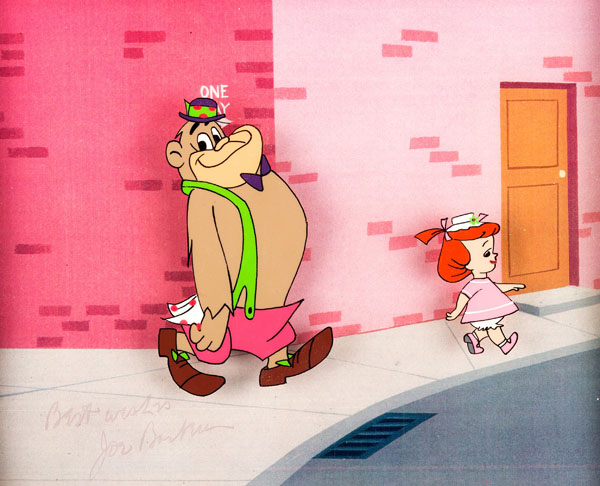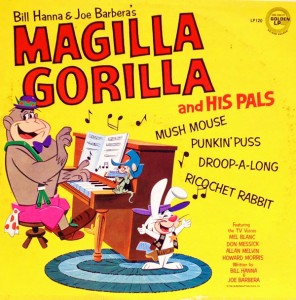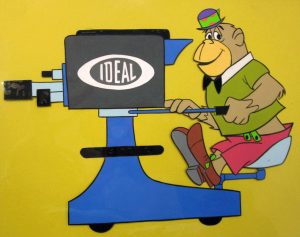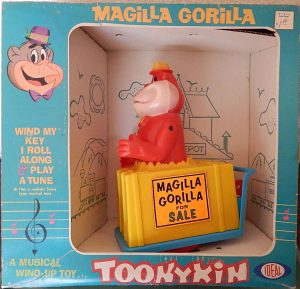
Of the many immediately singable theme songs from Hanna-Barbera that have seared themselves into our pop culture consciousness, the opening of The Magilla Gorilla Show ranks up there.
With a booming, big band sound, as the sun pops up over Peebles Pet Shop, the show begins with the strains of, “We’ve got a gorilla for sale/Magilla Gorilla for sale..,” and many a memory of childhood immediately resurfaces.
 With The Magilla Gorilla Show, which debuted in syndication on January 15, 1964, Hanna-Barbera used a format similar to that used on their shows like Huckleberry Hound, where the half-hour comprised three short-form cartoons.
With The Magilla Gorilla Show, which debuted in syndication on January 15, 1964, Hanna-Barbera used a format similar to that used on their shows like Huckleberry Hound, where the half-hour comprised three short-form cartoons.
“Magilla and his friends were introduced in a syndicated half-hour film called Here Comes a Star,” explained fellow Cartoon Research writer, Greg Ehrbar, author of the upcoming Hanna-Barbera: The Recorded History. “It was hosted by George Fenneman, the announcer for Groucho Marx on You Bet Your Life. The film offered an early glimpse into the newly constructed Hanna-Barbera studio, which still stands on Cahuenga Blvd. in Hollywood. There was even mention of their first animated feature, Hey There, It’s Yogi Bear.”
The series’ new character lineup included, of course, Magilla Gorilla (voiced by actor Allan Melvin, most famous as Alice’s boyfriend, Sam the butcher, on The Brady Bunch) who lives in the show window of Mr. Peebles pet shop (comedian Howard Morris of Your Show of Shows and The Andy Griffith Show). A cute little girl named Ogee (Jean Vander Pyl, most famous as the voice of Wilma Flintstone) is the only customer who seems to want to adopt Magilla.
 As Mr. Peebles is unable to sell Magilla, even after several markdowns, the primate, dressed in his bowler hat, bow tie, suspenders, and shorts, winds up getting into several adventures, including being in the Army, a movie star, and a surfer (where he introduces the oh-so-groovy-60s song, “Makin’ with the Magilla”).
As Mr. Peebles is unable to sell Magilla, even after several markdowns, the primate, dressed in his bowler hat, bow tie, suspenders, and shorts, winds up getting into several adventures, including being in the Army, a movie star, and a surfer (where he introduces the oh-so-groovy-60s song, “Makin’ with the Magilla”).
The song resulted in one of the hundreds of Hanna-Barbera recordings Greg describes in his book “It was arranged by Carole King, produced by Gerry Goffin and written by Jack Keller, Ed Justin, and Tony Powers, all at Columbia/Screen Gem’s music organization in New York,” said Greg. “This was the same place that generated songs for Screen Gems TV series like The Donna Reed Show and The Monkees, as well as for countless recording stars—including Little Eva, who had a huge hit with ‘Loco-Motion.’ Her single of ‘Makin’ with the Magilla’ is available to this day on CD and download.”
Another segment of the show was “Ricochet Rabbit and Droop-a-Long,” Western tales about the sheriff of the town Hoop N’ Holler: Ricochet (Don Messick), a fast-moving character who ricocheted from point to point, and introduced himself by making his own sound effects (“Ping! Ping PING!”). The sheriff’s trick bullets were comedic, as well as explosive. Ricochet’s sidekick was Droop-a-Long (Mel Blanc), a slow-moving coyote with his cowboy hat pulled down over his eyes.
The last segment of The Magilla Gorilla Show was “Punkin Puss & Mushmouse,” which was kind of Tom & Jerry meet The Hatfields and the McCoys, as a shotgun-carrying cat named Punkin. Puss (Melvin) always tries to catch a mouse named Mushmouse (Morris).
 Those were the three original segments of The Magilla Gorilla Show. However, in later syndication runs, the three segments of the separate Peter Potamus Show (Peter Potamus, Breezly, and Sneezly and Yippee, Yappee, and Yahooey) were incorporated into Magilla Gorilla.
Those were the three original segments of The Magilla Gorilla Show. However, in later syndication runs, the three segments of the separate Peter Potamus Show (Peter Potamus, Breezly, and Sneezly and Yippee, Yappee, and Yahooey) were incorporated into Magilla Gorilla.
When The Magilla Gorilla Show debuted, the sponsor was Ideal Toys, and their name and logo were incorporated not only into the opening and closing animation but into the theme song as well.
When the theme song chorus would sing, “…handsome, elegant, intelligent, sweet – he’s really Ideal!…,” Magilla would inflate a balloon with the Ideal Toys logo on it. After, Magilla would turn on a television with the show’s logo on the screen and announce, “Magilla Gorilla, sponsored by Ideal Toys! They’re wonderful toys! They’re Ideal.” He’d then giggle and say, “Get it?”
A similar Ideal sponsor moment was built into the ending theme of the show, as well. As The Magilla Gorilla Show continued in syndication in later years, the Ideal logo and dialogue were taken out.
Working Ideal into the theme song of the show was the creative work of composer Hoyt Curtin, who with Hanna and Barbera themselves, came up with of Hanna-Barbera’s most popular theme songs, running the eclectic gamut from The Flintstones to Jonny Quest and from Josie and the Pussycats to Super Friends.
 In addition to Hoyt Curtin, lots of other legends contributed to The Magilla Gorilla Show. The Story Director was Alex Lovy, who had directed several classic Woody Woodpecker shorts for Walter Lantz and worked for Columbia Pictures and Warner Bros. animation. Lovy also directed Hanna-Barbera’s first animated prime-time special, 1966’s Alice in Wonderland, or What’s a Nice Kid Like You Doing in a Place Like This?
In addition to Hoyt Curtin, lots of other legends contributed to The Magilla Gorilla Show. The Story Director was Alex Lovy, who had directed several classic Woody Woodpecker shorts for Walter Lantz and worked for Columbia Pictures and Warner Bros. animation. Lovy also directed Hanna-Barbera’s first animated prime-time special, 1966’s Alice in Wonderland, or What’s a Nice Kid Like You Doing in a Place Like This?
Members of the Story Team included Tony Benedict, who worked at both Disney and UPA before coming to Hanna-Barbera, contributing to many of their famous shows. There was also Warren Foster, who had started his animation career with the Fleischer Studios in the 1930s.
The Animation Director was Charles A. Nichols, who had worked on several of Disney’s most famous short subjects and features, including as co-director (with Ward Kimball) of the Academy Award-winning Toot, Whistle Plunk, and Boom. With another H-B legend, Iwao Takamoto, Nichols directed the beloved 1973 animated feature, Charlotte’s Web.
The stylish look and layout of Magilla Gorilla came from Iwao Takamoto, who also worked on a number of Disney’s classic features, such as Sleeping Beauty, before contributing to Hanna-Barbera’s celebrated shows in the 60s and 70s.
 Among the animators on the show were Kenneth Muse, Irv Spence, and Dick Lundy, who had all worked with Hanna and Barbera at MGM on many of the classic Tom and Jerry cartoons.
Among the animators on the show were Kenneth Muse, Irv Spence, and Dick Lundy, who had all worked with Hanna and Barbera at MGM on many of the classic Tom and Jerry cartoons.
All this talent on one show led to many clever, standout moments on The Magilla Gorilla Show. Looking to con Mr. Peebles out of some food, Magilla pretends to be depressed at not being purchased by a customer. To make him feel better, Peebles offers him a banana. “One shouldn’t eat when emotionally upset, but I will try to choke it down,” says Magilla.
In the “Good Little Bad Guy” cartoon of Ricochet Rabbit, a villainous bad guy spanks his overgrown adult son for going to school instead of following in the family business of crime; in Punkin Puss and Mushmouse’s “Shot at and Missed,” Mushmouse runs away to Beverly Hills, and Punkin Puss goes there to bring him back. The snooty cat who opens the door declares, “It’s so hard to keep a mouse these days,” and Magilla’s cartoon, “A Star is Bought,” is a sharp send-up of the movie business.
Celebrating its 60th anniversary this year, The Magilla Gorilla Show brings to mind a time when Hanna-Barbera seemingly ruled the airwaves, creating characters who would become canon for the studio and icons for fans.
The wonderful earworm of a theme song and all of The Magilla Gorilla Show brings us back to a time when a new animated show on TV was a clarion call for kids to gather in front of their parents’ oversized television set and ask, “How much is that Gorilla in the window?!”



 Michael Lyons is a freelance writer, specializing in film, television, and pop culture. He is the author of the book, Drawn to Greatness: Disney’s Animation Renaissance, which chronicles the amazing growth at the Disney animation studio in the 1990s. In addition to Animation Scoop and Cartoon Research, he has contributed to Remind Magazine, Cinefantastique, Animation World Network and Disney Magazine. He also writes a blog, Screen Saver: A Retro Review of TV Shows and Movies of Yesteryear and his interviews with a number of animation legends have been featured in several volumes of the books, Walt’s People. You can visit Michael’s web site Words From Lyons at:
Michael Lyons is a freelance writer, specializing in film, television, and pop culture. He is the author of the book, Drawn to Greatness: Disney’s Animation Renaissance, which chronicles the amazing growth at the Disney animation studio in the 1990s. In addition to Animation Scoop and Cartoon Research, he has contributed to Remind Magazine, Cinefantastique, Animation World Network and Disney Magazine. He also writes a blog, Screen Saver: A Retro Review of TV Shows and Movies of Yesteryear and his interviews with a number of animation legends have been featured in several volumes of the books, Walt’s People. You can visit Michael’s web site Words From Lyons at: 






















The scary part is that the Toonykin is more off-model than the “Makin With The Magilla” cover costume.
A reminder of why I obtained very little animation model merchandise during my life –
although the Funko Pop generation would disagree.
Oh they’ll certainly disagree. Being on-model isn’t their thing.
I was a preschooler when Magilla Gorilla premiered. I loved the show, partly because our next door neighbour was named Mr. Peebles. When my family got our first colour TV set in 1965, the first thing I saw on it was a Ricochet Rabbit cartoon. But I’m afraid I have absolutely no memory of Punkin Puss and Mush Mouse. Even Little Roquefort and Percy made a deeper impression on me than they did.
Another important contributor to The Magilla Gorilla Show was Hawaiian musician Jack de Mello, who composed many of its musical cues. These were very distinctive, often juxtaposing distantly related chords for comic effect, and they were subsequently reused in other Hanna-Barbera productions of the mid to late 1960s. Although his work usually went uncredited, he was as important a figure in establishing the signature Hanna-Barbera sound of the decade as Hoyt Curtin or Ted Nichols. De Mello passed away in 2019 at the age of 102.
Magilla Gorilla was one of my favorites as a kid; I can’t explain why. Maybe it was the catchy theme song, coupled with the clever animated gags and the stellar voice work. I just know that I loved it. I was also a big fan of Ricochet Rabbit, Droop-a-Long, Punkin Puss, and Mushmouse.
It was right around this time that the HBR Records made their debut. These were a cut above the usual children’s records. The Magilla record was a retelling (?) of Alice in Wonderland, which is purely the Magilla Gorilla version of the story, as it bears little to no resemblance to anything Lewis Carroll wrote. However, Alan Melvin does have a field day on the record, performing multiple voices and injecting more wackiness into an already wacky story. I think adults might actually enjoy the record more than kids. Ogee is performed not by Jean Van Der Pyl, who did the voice in the cartoons, and is credited on the album–but it’s actually Janet Waldo providing Ogee’s voice on the record. She also briefly voices Ogee’s mother. And instead of Howard Morris as Mr. Peebles, the voice is provided by Sam Edwards, who appeared on the Andy Griffith Show and also had a lengthy career with Disneyland Records. But once the story portion starts, no other voice is heard but that of Alan Melvin–until the very end when Ogee’s parents return home to find her asleep, only to be wakened by Magilla when he shouts for joy that he has found a home at last.
The Peter Potamus Show was also a big hit with me. These two generally ran in the same hour on weekday afternoons–although I definitely remember a Saturday afternoon debut show before the cartoons went into regular airing.
One issue, however, is that the DVD release of the Magilla series was presented without the opening and closing theme song and credits. This has never been rectified. The Saturday Morning 60’s sets did, however, include two episodes correctly shown with the opening and closing. But definitely a reissue of the series in its complete form is overdue.
Hi, FFW.We’d moved to my former hometown Whittier,Cal.,,inn early 1964 when I was threre, and this explains the answer what exactly NEW series did HB ever have for 196
Seeing that intro video brought back memories of watching this show on Boomerang in the early 2000s, but I never knew until now that it originally had that plug for Ideal Toys included. The version I recalled edited that sequence to have Magilla’s face on the balloon instead of the sponsor’s logo and changed the “sponsored by…” shucking to a more generic “and starring all my friends!” spiel.
Kudos to Boomerang for that suave “Gorilla 4 Sale” music video as well.
I was three when the show premiered…and I remembered the live-action documentary… “Here Comes A Star”… clearly staged, with George Fenniman visiting the H-B studios…and being given a tour and seeing the creation of Magilla Gorilla. It was wild seeing actual people making cartoons.
For some reason I don’t recall any of the Walter Lantz or Walt Disney “making of” clips…this was my introduction to the concept of people animating cartoons. Before that I just thought they were alive. It also made me think of animation as a career. So my memories of the character are always tied to that film.
I was not born when Magilla was first-run, but the reruns were on in NYC on either channel 5 or 11 in the late 70’s. And being an H-B fan as well as of other fun ‘toons, I had to get him on DVD.
I did not know Little Eva, known for the original version of The Loco-Motion (Grand Funk Railroad then Kylie Minogue would do covers, both went to #1 on the Hot 100 as did Little Eva’s version), sang “Makin with the Magilla.”
Thanks for including the video of the Ideal opening and closing…complete with Screen Gems’ “Walking Sticks” logo…in brilliant color.
Happy 60th Magilla!
Childhood memories of a comic book that had Magilla running for President against Yogi Bear. Mr. Peeble reasoned that if Magilla was elected, he’d move out of the pet shop and into the White House, and recruited Top Cat as campaign manager. Yogi’s campaign was managed by Huckleberry Hound.
I was nine and old enough to have followed HB shows from the beginning. Recall favoring Peter Potamus, because the balloon boat struck me as really cool (like a flying camper, and you probably didn’t need to be old enough to drive).
For a time HB characters were licensed to Great America in Santa Clara, CA (following the Warner characters and preceding Nicktoons and Peanuts). A little merry-go-round with animal-faced cars was named Mr. Pebble’s Pet Shop. This was in the 80s or later, making it a super-obscure reference for actual kids.
As a kid I looked forward to it until I saw an episode. Hanna Barbera was starting to seem repetitive, and without the humor of Huckleberry and Quick Draw. They seemed more interested in alliterative names than clever cartoons.
In the show’s closing credits, the Magilla Theme is credited to “Nelson Brock”. This was Nelson Brock Winkless, Jr., an ad man for the Leo Burnett agency. He had previously written the “Good morning” jingle for Kellogg’s Corn Flakes and “Snap, Crackle, Pop” for Rice Krispies, and he would later compose the “Tra La La” theme song for the Kellogg’s-sponsored Banana Splits Adventure Hour, though he went uncredited for that because of contractual reasons. In any event, the orchestral arrangement of the Magilla Gorilla theme definitely sounds like Curtin’s work.
Winkless’s grandson and namesake, N. Brock Winkless IV, was a puppeteer who operated the Cryptkeeper for “Tales from the Crypt” as well as Chucky in the “Child’s Play” movies.
Three of his sons were the performers inside of the Banana Splits costumes too.
It was when Magilla and Peter migrated to Saturday morning on ABC at midseason of 1965-66 when they exchanged features as I recall.
Going through something about Magilla Gorilla, I must say the highlight was that girl in a bikini on the album cover.
Editor: I forgot my site address: https://thegoldenageofanimation.blogspot.com/
Regarding “Here Comes a Star”, the special was apparently edited on the so-called “complete” DVD set(as mentioned above, without the openings and closings of the show). Any idea on what was removed?
Film critic and historian Leslie Halliwell (Halliwell’s Film Guide) liked M.G. mildly, giving it one star in his four-star rating system (about equal to **½ from Leonard Maltin).
Better than mine: 0 out of 10.
Still, for one keen into fanfiction possibilities for even the more esoteric of Hanna-Barbera stars, Magilla Gorilla has plenty of potential.
Once, inspired by a joke on the now-defunct public radio show A Prairie Home Companion about “even gorillas like sasparilla,” I worked out a fanfic in which Magilla was recruited to do TV commercials for a small-time brand of sasparilla (in English and Spanish, know) which, because of Magilla’s delivery or somesuch, caused the brand to become unusually popular so that the company had to go on double shift just to meet demand as stores ran out rather suddenly. So successful, in fact, that the campaign was cut short after two weeks, though not before a supermarket appearance which included a run-in with Bingo from The Banana Splits as included some arm-wrestling challenges “going viral.”
(Which is but one example.)
I’ve also had Magilla on occasion as part of a diving party led by Peter Potamus, going around the country on rather interesting SCUBA adventures and occasionally turning up as a summer camp counsellor specialist in diving.
Come to think of it, alongside Magilla, which other esoteric Hanna-Barbera characters might have rehabilitative possibilities?
(Correct me if I’m wrong, but Magilla’s name is from the Yiddish megillah, which can translate as “wild” or “crazy.”)
You’re thinking of “meshugga”, which means “crazy”. The Hebrew word “Megillah” means “scroll” or “volume”, often referring to the biblical Book of Esther, which is read aloud in its entirety on the holiday of Purim. Thus in Yiddish, “Megillah” has come to mean a lengthy, long-winded account or explanation.
Such as Magilla was bound to get into with Mr. Peebles after another attempt to sell Magilla as a housepet went bust.
Howard Morris was replaced by Don Messick as the voice of Mr. Peebles toward the end of Magilla Gorilla’s run.
“Howard Morris was replaced by Don Messick as the voice of Mr. Peebles toward the end of Magilla Gorilla’s run.”
It was a noticeable difference too. For once, Messick wasn’t as good as the original. His Atom Ant and Dr. Benton Quest rescues (replacing Morris and John Stephenson) were much better.
Nice to see Nelson Brock was a real guy., Loved it.
And also on the additional, ‘newer’ H-B composers Marty Paitch, whose son David worked with a wide variety of artists from Toto to Babs Streisand, did a lot of that uncredited 1960s HB music.
The 1966 special Alice and Flintstone spy movie helped to intro’ a lot of it,too!
Steve
The Magilla Gorilla Show DVD marks perhaps the most puzzling release in the whole Hanna-Barbera “funny animal” catalogue. Not only did they somehow leave out the catchy theme song (the best part of the whole show), many episodes, including Punkin Puss and Ricochet Rabbit, are of sub-par visual quality, looking like they were struck from cheap VHS sources. It’s also the first HB “funny animal” series to not use Daws Butler’s voice talents, another strike against it in my book.
By the time Magilla came along, Hanna-Barbera was clearly running low on ideas. The imprisoned animal who escaped for excitement was a semi-Yogi/definite Wally Gator retread (as was Squiddly Diddly). Ricochet Rabbit crossed Quick Draw McGraw with Speedy Gonzales. Punkin Puss & Mush Mouse was just another in a long line of cat vs. mouse toons. None of these “new characters” made me laugh like I did at Yogi, Huck, Quick Draw and the classic early stars.
I feel like that was the reason the 2021 show, Jellystone! made the attempt to add more variations to the Hanna Barbera characters to the point they even changed the personalities of some of them, gender swapping aside for a select few. Although Magilla wasn’t terribly unique, I think the titular character and the other supporting characters had a certain charm about them I still quite enjoyed. Likewise, I prefer more Yogi, Huck and Quick Draw.
“I feel like that was the reason the 2021 show, Jellystone! made the attempt to add more variations to the Hanna Barbera characters to the point they even changed the personalities of some of them, gender swapping aside for a select few.”
Jellystone is the WORST abomination ever of the classic HB stars. Made me want to gouge my eyeballs out.